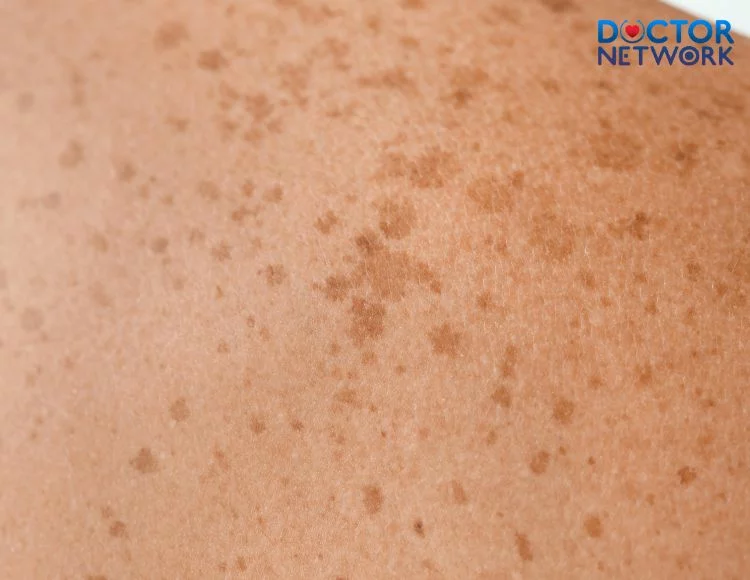Appearance of dark spots on the skin is a common concern in skincare, especially among those who frequently expose themselves to sunlight and have skin damage. Understanding and addressing this issue is not only about aesthetics but also crucially related to skin health. Let’s explore the issue of dark spots on the skin through the following article.
Causes and Factors Leading to Dark Spots on the Skin
Impact of Sunlight and UV Rays on the Skin
Sunlight contains UV rays that can damage the skin, including increasing melanin production. Melanin is the skin’s natural pigment produced by melanocyte cells, and it protects the skin from UV damage. However, excessive sun exposure can increase melanin production, leading to the formation of dark spots on the skin.

Sunlight contains UV rays that can damage the skin, including increasing melanin production
Melanin Production Instability on the Skin
The mechanism of melanin production can be influenced by various factors, including genetics, age, and environmental factors. Instability in this process can lead to uneven melanin accumulation on the skin’s surface, causing dark spots.
Environmental Impact and Skin Aging
Modern living environments with constant exposure to harmful factors like air pollution, cigarette smoke, and chemicals from petroleum products play a significant role in causing dark spots on the skin. Additionally, the natural aging process of the skin can also be a significant factor, leading to uneven skin tone and unwanted dark spots.
Signs and Symptoms of Dark Spots on the Skin
Uneven Dark Spots on the Skin
One of the clear signs of dark spots on the skin is the presence of unevenly colored patches. Dark spots often appear in areas directly exposed to sunlight, such as the face, neck, and hands. These spots can vary in size and shape, from small spots to larger areas covering the skin.
Skin Discoloration and Unevenness
With dark spots on the skin, the skin’s color often becomes uneven and darker. The dark spots can vary in shades of brown or even appear reddish, depending on the extent of skin damage and increased melanin production.
Freckles and Hyperpigmentation
In some cases, dark spots on the skin can be accompanied by the appearance of freckles and hyperpigmentation. Freckles typically appear as evenly colored brown patches, while hyperpigmentation is uneven dark patches on the skin’s surface. This can make the skin appear uneven and less naturally beautiful.

In some cases, dark spots on the skin can be accompanied by the appearance of freckles and hyperpigmentation
Impact of Dark Spots on Health and Appearance
Negative Impact on Skin Health and Uneven Skin Tone
Dark spots can lead to skin health issues, including skin damage and increased risk of skin-related diseases such as skin cancer and dermatitis. Dark spots often appear in areas of the skin damaged by sunlight, reducing the skin’s protective abilities against environmental factors. Additionally, uneven skin tone can affect the natural beauty and confidence of those affected.
Impact on Confidence and Mood
The appearance of dark spots on the skin can reduce confidence and cause discomfort for individuals. Those affected may feel self-conscious in social interactions and public appearances. This condition can lead to psychological issues like anxiety, self-consciousness, and stress, affecting their daily quality of life.
In general, the impact of dark spots on the skin not only affects physical health but also mood and psychological well-being. Therefore, treating and preventing this issue is essential not only for health benefits but also to improve the affected person’s quality of life and mental well-being.
Treatment and Prevention Methods
Use of Sunscreen and Daily Skincare Products
Using sunscreen is crucial to protect the skin from UV rays, the primary cause of dark spots. Sunscreen not only helps prevent melanin production but also protects the skin from sun damage. Additionally, using daily skincare products, such as moisturizers and anti-aging serums, can help improve skin condition and reduce the appearance of dark spots.

Using sunscreen is crucial to protect the skin from UV rays, the primary cause of dark spots
Therapeutic Methods like Laser, Chemical Peeling, and Spot Treatment Technologies
There are several effective therapeutic methods to minimize or remove dark spots on the skin. These methods include using lasers to target specific pigmented melanin cells, chemical peeling to remove the epidermis layer containing excess melanin, and spot treatment technologies like IPL (Intense Pulsed Light) to effectively and safely reduce the appearance of dark spots.
Healthy Lifestyle and Protecting the Skin from Sun Exposure
Protecting the skin from sun exposure is an essential part of preventing and treating dark spots. This includes avoiding direct sunlight between 10 am and 4 pm, wearing protective clothing and broad-brimmed hats, and seeking shade when outdoors. Additionally, maintaining a healthy lifestyle, including balanced diet, regular exercise, and stress reduction, can also help improve skin health and natural beauty.
These measures together form a comprehensive approach to treat and prevent dark spots on the skin, while also improving skin health and natural beauty.
Some scientific references regarding “dark spots on the skin”
Here are some scientific references regarding “dark spots on the skin“:
1. Article: “Impact of UV Rays on the Skin” published in the British Journal of Dermatology in 2019. This article discusses the effects of UV rays on the skin, including the formation of dark spots.
2. Study: A study published in the Clinical and Aesthetic Dermatology Journal in 2014 found that UV rays are the primary cause of melasma, a common type of dark spots.
3. Study: A study published in the British Journal of Dermatology in 2017 indicated that pregnant women are at higher risk of developing melasma due to hormonal changes.
4. Study: A study published in the British Journal of Dermatology in 2018 found that individuals with a family history of melasma have a higher risk of developing the condition.
5. Study: A study published in the British Journal of Dermatology in 2019 showed that smoking can increase the risk of developing melasma.
These scientific references provide evidence-based information on the causes and risk factors associated with the appearance of dark spots on the skin.
Dark spots on the skin are not just a cosmetic concern but also affect health and mood. Taking preventive measures like avoiding direct sun exposure and wearing protective clothing when outdoors plays a significant role in maintaining healthy skin.
References:
https://www.mayoclinic.org/diseases-conditions/age-spots/symptoms-causes/syc-20355859
https://my.clevelandclinic.org/health/diseases/21885-hyperpigmentation
Kiểm Duyệt Nội Dung
More than 10 years of marketing communications experience in the medical and health field.
Successfully deployed marketing communication activities, content development and social networking channels for hospital partners, clinics, doctors and medical professionals across the country.
More than 6 years of experience in organizing and producing leading prestigious medical programs in Vietnam, in collaboration with Ho Chi Minh City Television (HTV). Typical programs include Nhật Ký Blouse Trắng, Bác Sĩ Nói Gì, Alo Bác Sĩ Nghe, Nhật Ký Hạnh Phúc, Vui Khỏe Cùng Con, Bác Sỹ Mẹ, v.v.
Comprehensive cooperation with hundreds of hospitals and clinics, thousands of doctors and medical experts to join hands in building a medical content and service platform on the Doctor Network application.

























